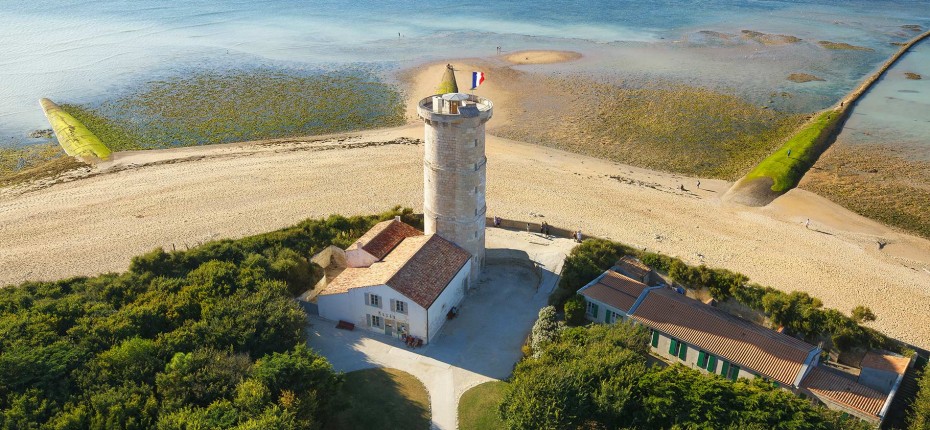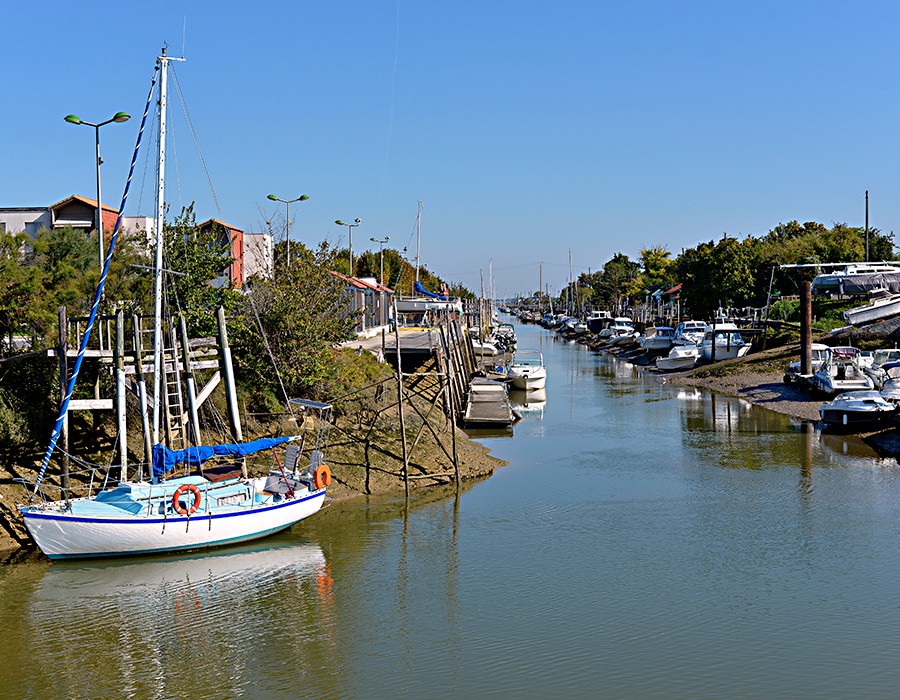
The peaceful villages of the Charente-Maritime
-
 6 minutes
6 minutes
-
 Culture & food
Culture & food
In the department of Charente-Maritime, you can explore some very special towns and places, a fascinating culture and an impressive gastronomic heritage. But less well known is the fact that the area’s identity is also expressed in its villages. Discover all the facets of the department by visiting its most beautiful villages on the islands, the mainland and on the Arvert Peninsula.
Ars-en-Ré and La Flotte : where tranquillity reigns
While there are plenty of places to visit in the Charente-Maritime, the Île de Ré is one of the absolute must-sees. A gem to be seen at least once in your life. The island may be small but it inspires some very pleasant feelings. For example, being constantly faced with the vastness of the Atlantic on this tiny stretch of land instils a much sought-after sense of release.
To find out for yourself, simply relax and stroll through its villages, such as Ars-en-Ré. A thousand or so people live there all year round, but that number swells in the summer. Why? Because Ars really condenses all that the Île de Ré has to offer.
From its famous alleyways, the narrow paved streets that are typical of the region, and the nearby salt marshes to the magnificent Saint-Etienne church with its black and white steeple and the port, Ars-en-Ré is such a soothing place.



This sense of peace was also felt by the fishing crews when at last they spotted the island after a long trip out to sea. The steeple of Ars was their landmark before they headed towards La Flotte. Like them, you will start your tour of the village at the port and its promenade. Take a seat in one of the bars or restaurants and spend a few minutes admiring the view.
Then head for the market, the village’s bustling social hub. This will be the ideal opportunity to sample the Charentais specialities before continuing your trip around the island or elsewhere.

Saint-Trojan-les-Bains : the pride of the island of Oléron

After admiring Ré, the first of the Charente islands’ gems, instinct will set you on the road to the other main island: Oléron. The country’s second-largest island after Corsica, Oléron is also brimming with lovely places for you to visit during your camping holiday in the Charente-Maritime.
We recommend you venture as far as the extreme south of the island where the scenery is captivating. But to do so, you’ll first need to go to Saint-Trojan-les-Bains. This seaside resort is considered by many to be THE must-see destination on Oléron.
To understand this reputation, simply stroll along the promenade by the small beach. With the fine sand and the ocean’s beauty on one side and the typical Belle Époque villas on the other, Saint-Trojan will take you back in time. For just a few minutes, relive the late 19th and early 20th century, one of the island’s most prosperous periods.
Once you’ve finished gazing out to sea, head for the historical centre where the old buildings and the houses with their multicoloured shutters lend a peaceful atmosphere to the flower-lined lanes. A perfect setting for a stroll under the lovely Charentais sunshine. This atmosphere can be felt as far as the port with its coloured huts occupied by craftspeople or oyster farmers.
And while in many villages – here in the Charente-Maritime or elsewhere – this kind of visit would be enough to fill you with wonder, in Saint-Trojan-les-Bains the enjoyment goes on and on. For your next surprise, go to the station where a little train awaits. The locomotive will take you to the pine groves that the locals planted on the dunes in the past.
All along your journey through this inspiring environment, you will come across a wealth of fauna and flora. You can also discover the island’s craft industry and one particular local tradition – the pine resin harvest. And to top it all off, the cycle paths and footpaths waymarked in the forest will leave you wanting to come back for more.


And yet the trip here is not only worth it for the vast forest. You should also check out the surroundings. Start with the splendid bay of Gatseau which borders the pine groves, looking back to the mainland. Further along, the trees give way to the southerly tip of the island and the Pertuis de Maumusson channel. Here the coastline is vast and wild. It’s not the edge of the world but it certainly looks like it…
Brouage : a historic place
While the islands have their own specific identity and charm, the mainland villages are also worth a visit.
Take Brouage, for example. The sea is still close by and the wonderful view from the marshland is on a par with anything the islands have to offer. You’ll find the same peacefulness and house fronts. The streets are wider, however.
And if there’s one thing that’s clearly felt here, it’s the sense of History. The ramparts
set the scene as soon as you arrive: this is an old 17th-century citadel, subsequently consolidated by Vauban.

As impressive as this boundary wall is, it is not the only evidence of Brouage’s history. To appreciate this, head for Saint-Pierre-et-Saint-Paul church. The side naves and the wooden vault, reminiscent of a ship’s hull, are very beautiful, but the most striking features are the stained-glass windows. They depict the creation of “Nouvelle France”, the former French colony founded in North America. The project was overseen by the best-known person to come from Brouage, the navigator Samuel de Champlain.


The windows actually come from Canada where the heritage of Nouvelle-France lives on, with French being the main language spoken in the province of Quebec. Brouage is therefore a must-see in the Charente-Maritime, and a symbolic site in a chapter of the history of France and North America.
The treasures of the south: from the Avert Peninsula to the Gironde estuary
We can’t present the Charente-Maritime without mentioning the far south of the department. In fact, this southern area is a real journey in itself.
Your trip will begin with the Arvert Peninsula and more specifically La Tremblade. Here you’ll find one of the most authentic villages of the department. The pace of life is still very much dictated by oyster farming. So head to the port and sample the delicious oysters in an inspiring setting on the banks of the Seudre, surrounded by the traditional coloured huts.
And if you’re still peckish after that, the Train des Mouettes is sure to appeal. Enjoy a meal showcasing local produce during a train journey through the salt marshes. The locomotive will also take you to another outstanding village: Mornac-sur-Seudre.
This village has long been associated with the salt industry, as demonstrated by the salt-workers’ stone houses found here. There are also the more picturesque old sailors’ houses, built using lime.



After admiring the Peninsula, head back for the coast and the Côte de Beauté. This area owes its reputation to Royan, an emblematic town in the Charente-Maritime, although the surrounding villages are also a great way to discover the coast’s natural riches.
For example, you can visit Les Mathes, known for its seaside resort La Palmyre. Whilst there, take the opportunity for some fun in the water. But there is more to Les Mathes than that, because upstream of the beach you’ll find the State Forest of Saint-Augustin, which includes some great hiking trails suitable for every level. A diverse choice sure to please nature lovers.
Finally, let’s end our escapade in one of the most beautiful places in western France: the Gironde Estuary. This unique destination, where the Garonne and the Dordogne meet, offers some breathtaking landscapes. You can admire, for example, the “carrelets” the fishing huts built on stilts. As in the rest of the department, the Gironde Estuary has strong links with the fishing industry.
And in this true slice of paradise, one haven of peace commands much attention: Talmont-sur-Gironde. Nestled on the water’s edge, this village boasts all the traditional local features. Namely:
- A picturesque centre, marked by flower-lined alleys and stone houses
- Cliffs, including Le Caillaud cliff where the waves crash against the natural wall
- And of course, the famous Charentais carrelet huts
However, Talmont has its own distinctive characteristics which make the village unique. First, there is its small vineyard on the sea front, producing mineral wines. And one thing you mustn’t miss is Sainte-Radegonde church, which overlooks the estuary. An impressive parish building which took three centuries to complete.

The church offers an outstanding viewpoint and is the perfect place to bring an end to this tour of the Charente-Maritime’s villages. An entrancing destination with so much to see and do, ideal for a camping holiday!


